The multi-axis truss robot market is projected to grow from USD 1,613.3 million in 2025 to USD 3,515.5 million by 2035, reflecting a forecast CAGR of 8.1%. Year-on-year data indicates steady growth, with the market expected to reach approximately USD 1,744.0 million in 2026, USD 1,885.3 million in 2027, and USD 2,038.0 million in 2028. This pattern demonstrates consistent adoption of multi-axis robotic systems in manufacturing, assembly, and automation applications.
The increasing integration of precise motion control, repeatability, and complex operation capabilities into production lines is expected to remain a key driver of growth. Industrial sectors are projected to increasingly rely on these robotic solutions to optimize efficiency, improve throughput, and reduce operational bottlenecks. The demand trajectory reflects the need for flexible, high-performance automation systems that can support intricate manufacturing processes, leading to robust market expansion across the forecast period.
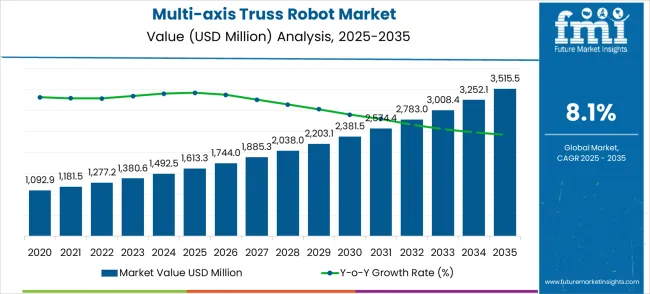
YoY growth analysis highlights that the market will experience moderate acceleration in early years, with annual growth rates ranging between 8% and 8.5%, gradually stabilizing as adoption matures. By 2029, the market is anticipated to reach USD 2,203.1 million and expand to USD 2,381.5 million in 2030, progressing to USD 2,574.4 million in 2031 and USD 2,783.0 million in 2032. Growth momentum is expected to continue through 2035, culminating at USD 3,515.5 million. The increasing deployment in high-precision automation, aerospace assembly, and industrial fabrication is expected to reinforce demand. Factors such as enhanced accuracy, multi-degree motion capability, and reduced operational downtime are likely to drive incremental adoption. The market exhibits a strong upward trend, reflecting its crucial role in transforming complex manufacturing workflows and positioning multi-axis truss robots as vital assets for enhancing industrial productivity and operational optimization.
| Multi-axis Truss Robot Market | Value |
|---|---|
| Market Value (2025) | USD 1,613.3 million |
| Market Forecast Value (2035) | USD 3,515.5 million |
| Market Forecast CAGR | 8.1% |
The multi-axis truss robot market holds a significant position within the industrial robots market, contributing around 15% of the total share, as these robots are widely deployed for complex tasks requiring high precision and flexibility. Within the automation equipment market, it accounts for about 12%, reflecting its integration into automated production lines across various industries. In the manufacturing robotics market, the share is estimated at 13%, driven by the need for multi-axis robots in large-scale manufacturing and assembly operations. The electronics assembly robotics market sees roughly 9% share, where these robots facilitate precise handling of delicate components. Finally, in the precision machinery market, the multi-axis truss robot market holds around 7%, emphasizing its role in high-accuracy manufacturing applications. Collectively, these contributions demonstrate its growing influence in precision-driven industrial automation.
Market expansion is being supported by the rapid increase in industrial automation worldwide and the corresponding need for precision manufacturing equipment that provides superior accuracy and operational reliability for advanced manufacturing processes. Modern manufacturing facilities rely on consistent automation performance and precision quality to ensure optimal production efficiency including automotive plants, electronics manufacturing, and aerospace facilities. Even minor precision variations can require comprehensive process adjustments to maintain optimal manufacturing standards and quality performance.
The growing complexity of manufacturing automation requirements and increasing demand for high-precision assembly solutions are driving demand for multi-axis truss robots from certified manufacturers with appropriate precision capabilities and automation expertise. Manufacturing companies are increasingly requiring documented accuracy specifications and system reliability to maintain production quality and operational efficiency. Industry specifications and automation standards are establishing standardized manufacturing procedures that require specialized robotic technologies and trained automation personnel.
The market is segmented by axis configuration, application, and region. By axis configuration, the market is divided into two-axis, three-axis, four-axis, five-axis, six-axis, and other configurations. Based on application, the market is categorized into automobile manufacturing, metallurgy casting, electronic communications, aerospace, and military research. Regionally, the market is divided into North America, Europe, East Asia, South Asia & Pacific, Latin America, and Middle East & Africa.
In 2025, the four-axis multi-axis truss robot segment is projected to capture around 35% of the total market share, making it the leading configuration category. This dominance is largely driven by the widespread adoption of versatile automation systems that provide optimal balance between operational complexity and precision capability, catering to a wide variety of manufacturing applications. The four-axis configuration is particularly favored for its ability to deliver effective automation performance in both standard and complex assembly operations, ensuring manufacturing flexibility. Automotive manufacturers, electronics producers, industrial assembly facilities, and precision manufacturing complexes increasingly prefer this configuration, as it meets operational automation needs without imposing excessive system complexity or programming requirements.
The availability of well-established product lines, along with comprehensive programming options and technical support from leading manufacturers, further reinforces the segment's market position. Additionally, this configuration category benefits from consistent demand across regions, as it is considered a practical and efficient solution for facilities requiring reliable automation systems and operational versatility. The combination of precision, flexibility, and cost-effectiveness makes four-axis multi-axis truss robots a dependable choice, ensuring their continued popularity in the industrial automation and manufacturing equipment markets.
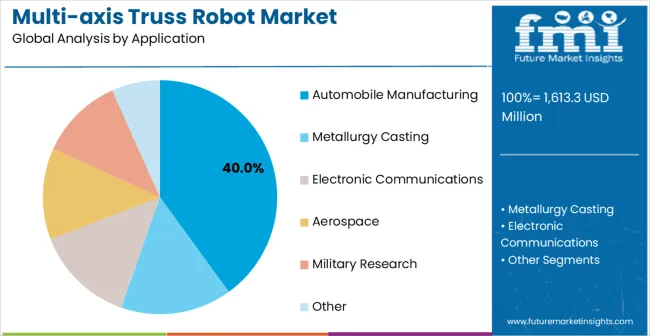
The automobile manufacturing segment is expected to represent 40% of multi-axis truss robot demand in 2025, highlighting its position as the most significant application sector. This dominance stems from the essential automation requirements of automotive production environments, where precision assembly and consistent quality are critical to vehicle manufacturing standards and production efficiency. Automobile manufacturing often features complex assembly processes that demand specialized automation equipment throughout extensive production lines, requiring reliable and precise robotic solutions. Multi-axis truss robots are particularly well-suited to these environments due to their ability to provide consistent precision performance and operational reliability, even during high-volume production conditions.
As automotive industries expand globally and emphasize improved manufacturing efficiency, the demand for multi-axis truss robots continues to rise. The segment also benefits from heightened quality standards within the automotive industry, where manufacturers are increasingly prioritizing automation precision and production consistency as essential manufacturing measures. With automotive companies investing in advanced manufacturing technologies and Industry 4.0 standards, multi-axis truss robots provide an essential solution to maintain high-performance vehicle production. The growth of electric vehicle manufacturing, coupled with increased focus on production automation standards, ensures that automobile manufacturing will remain the largest and most stable demand driver for multi-axis truss robots in the forecast period.
The multi-axis truss robot market is advancing rapidly due to increasing industrial automation development and growing recognition of robotic automation advantages over manual processes in precision manufacturing applications. However, the market faces challenges including high initial investment costs compared to traditional automation solutions, need for specialized programming and maintenance expertise, and integration complexity with existing manufacturing systems across different industrial environments. Precision optimization efforts and artificial intelligence integration programs continue to influence equipment development and market adoption patterns.
The growing development of advanced control systems and artificial intelligence integration is enabling higher precision accuracy with improved operational efficiency and enhanced automation capabilities. Advanced control technologies and optimized motion algorithms provide superior manufacturing precision while maintaining operational flexibility requirements. These technologies are particularly valuable for manufacturing operators who require reliable automation performance that can support extensive production operations with consistent precision results.
Modern multi-axis truss robot manufacturers are incorporating advanced Industry 4.0 capabilities and intelligent monitoring systems that enhance operational efficiency and manufacturing effectiveness. Integration of predictive maintenance systems and optimized data analytics enables superior production optimization and comprehensive manufacturing intelligence capabilities. Advanced smart features support operation in diverse manufacturing environments while meeting various efficiency requirements and automation specifications.
The multi-axis truss robot market is entering a new phase of growth, driven by demand for industrial automation, manufacturing expansion, and evolving precision and efficiency standards. By 2035, these pathways together can unlock USD 700-900 million in incremental revenue opportunities beyond baseline growth.
Pathway A -- Versatile Configuration Leadership (Four-Axis Systems) The four-axis segment already holds the largest share due to its balance of complexity and versatility. Expanding precision optimization, control enhancement, and application flexibility can consolidate leadership. Opportunity pool: USD 200-270 million.
Pathway B -- Core Manufacturing Applications (Automotive & Electronics) Automobile manufacturing accounts for the largest demand. Growing automotive production, especially in emerging economies, will drive higher adoption of multi-axis truss robots for precision assembly. Opportunity pool: USD 150-200 million.
Pathway C -- Advanced Axis Configurations (Five & Six-Axis Growth) Higher complexity systems are expanding with increasing focus on precision manufacturing. Robots designed for complex assembly operations can capture significant growth. Opportunity pool: USD 100-140 million.
Pathway D -- Emerging Market Expansion Asia-Pacific and Latin America present growing demand due to rising manufacturing infrastructure. Targeting automation networks and competitive solutions will accelerate adoption. Opportunity pool: USD 80-120 million.
Pathway E -- Smart Manufacturing & Industry 4.0 Integration With increasing digitalization, there is an opportunity to promote AI-enabled and IoT-connected robotic systems for intelligent manufacturing. Opportunity pool: USD 60-80 million.
Pathway F -- Specialized Industry Applications Systems optimized for aerospace, military research, and advanced manufacturing offer premium positioning for high-precision industrial facilities. Opportunity pool: USD 40-60 million.
Pathway G -- Service, Maintenance & Lifecycle Support Recurring revenue from maintenance services, programming support, and system upgrades creates long-term revenue streams. Opportunity pool: USD 30-50 million.
Pathway H -- Digital Integration & Predictive Analytics Digital performance monitoring, predictive maintenance, and manufacturing analytics can elevate robots into "smart manufacturing" equipment categories. Opportunity pool: USD 20-30 million.
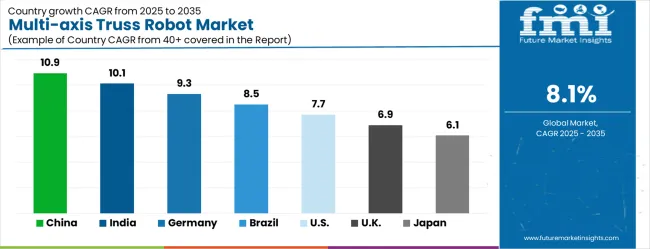
| Country | CAGR (2025-2035) |
|---|---|
| China | 10.9% |
| India | 10.1% |
| Germany | 9.3% |
| Brazil | 8.5% |
| United States | 7.7% |
| United Kingdom | 6.9% |
| Japan | 6.1% |
The multi-axis truss robot market is growing rapidly, with China leading at a 10.9% CAGR through 2035, driven by massive industrial automation development and increasing adoption of advanced manufacturing technologies. India follows at 10.1%, supported by rising manufacturing infrastructure development and growing awareness of automation benefits. Germany grows strongly at 9.3%, integrating advanced robotics into its established industrial manufacturing infrastructure. Brazil records 8.5%, emphasizing industrial modernization and automation upgrade initiatives. The United States shows solid growth at 7.7%, focusing on manufacturing efficiency enhancement and automation optimization. The United Kingdom demonstrates steady progress at 6.9%, maintaining established industrial automation applications. Japan records 6.1% growth, concentrating on precision advancement and specialized automation applications.
The report covers an in-depth analysis of 40+ countries, the top-performing countries are highlighted below.
The multi-axis truss robot market in China is projected to exhibit the highest growth rate with a CAGR of 10.9% through 2035, driven by unprecedented expansion of manufacturing automation infrastructure and increasing demand for advanced industrial robotics. The country's massive manufacturing sector and expanding automotive production facilities are creating enormous demand for precision automation solutions. Major manufacturers are establishing comprehensive robotics integration networks to support the increasing requirements of industrial companies and manufacturing facilities across production regions.
Government Industry 4.0 development initiatives are supporting establishment of smart manufacturing facilities and automated production complexes, driving demand for advanced robotics throughout major industrial zones. Manufacturing sector modernization programs are facilitating adoption of intelligent automation technologies that enhance production efficiency and quality standards across industrial networks.
The multi-axis truss robot market in India is expanding at a CAGR of 10.1%, supported by increasing manufacturing sector development and growing awareness of industrial automation benefits. The country's expanding automotive and electronics manufacturing infrastructure and rising production quality standards are driving demand for advanced robotics solutions. Manufacturing companies and industrial facilities are gradually implementing precision automation equipment to maintain competitive standards and operational efficiency.
Industrial sector growth and manufacturing infrastructure development are creating opportunities for suppliers that can support diverse automation requirements and precision specifications. Professional training and technical programs are building expertise among manufacturing personnel, enabling effective utilization of multi-axis robot technology that meets industrial automation standards and production requirements.
The multi-axis truss robot market in Germany is projected to grow at a CAGR of 9.3%, supported by the country's emphasis on Industry 4.0 standards and advanced manufacturing technology adoption. German manufacturing facilities are implementing sophisticated automation systems that meet stringent precision requirements and operational specifications. The market is characterized by focus on technological excellence, manufacturing precision, and compliance with comprehensive automation standards.
Manufacturing industry investments are prioritizing cutting-edge automation technology that demonstrates superior performance and reliability while meeting German quality and efficiency standards. Professional certification programs are ensuring comprehensive technical expertise among automation personnel, enabling specialized robotics capabilities that support diverse manufacturing applications and facility requirements.
The multi-axis truss robot market in Brazil is growing at a CAGR of 8.5%, driven by increasing industrial facility development and growing recognition of automation technology advantages. The country's expanding automotive and manufacturing sectors are gradually integrating advanced robotics to enhance production efficiency and quality standards. Industrial facilities and manufacturing plants are investing in automation technology to address evolving production requirements and competitive pressures.
Industrial facility modernization is facilitating adoption of advanced automation technologies that support comprehensive manufacturing capabilities across industrial regions. Professional development programs are enhancing technical capabilities among manufacturing personnel, enabling effective multi-axis robot utilization that meets evolving industrial standards and production requirements.
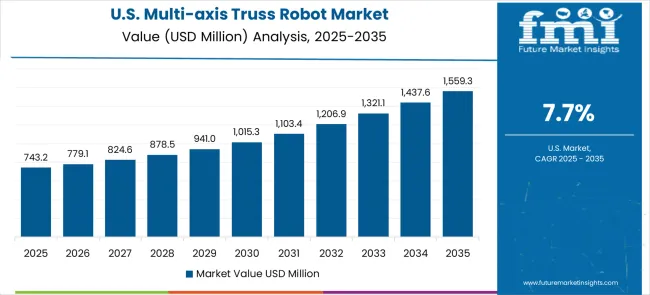
The multi-axis truss robot market in the United States is expanding at a CAGR of 7.7%, driven by established manufacturing industries and growing emphasis on production efficiency enhancement. Large manufacturing companies and industrial automation providers are implementing comprehensive robotics capabilities to serve diverse production requirements. The market benefits from established automation distribution networks and professional development programs that support various manufacturing applications.
Manufacturing industry leadership is enabling standardized robotics utilization across multiple production types, providing consistent efficiency standards and comprehensive automation coverage throughout regional markets. Professional development and certification programs are building specialized technical expertise among manufacturing personnel, enabling effective multi-axis robot utilization that supports evolving industrial facility requirements.
The multi-axis truss robot market in the United Kingdom is projected to grow at a CAGR of 6.9%, supported by established manufacturing sectors and growing emphasis on automation efficiency capabilities. British manufacturing facilities and industrial service providers are implementing robotics systems that meet industry efficiency standards and operational requirements. The market benefits from established manufacturing infrastructure and comprehensive training programs for automation professionals.
Manufacturing facility investments are prioritizing advanced robotics that support diverse production applications while maintaining established efficiency and quality standards. Professional development programs are building technical expertise among manufacturing personnel, enabling specialized multi-axis robot operation capabilities that meet evolving facility requirements and efficiency standards.
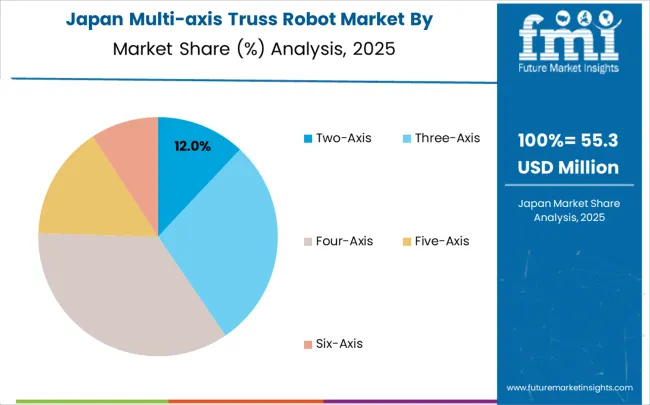
The multi-axis truss robot market in Japan is growing at a CAGR of 6.1%, driven by the country's focus on manufacturing technology innovation and precision enhancement applications. Japanese manufacturing facilities are implementing advanced robotics systems that demonstrate superior precision reliability and operational consistency. The market is characterized by emphasis on technological excellence, quality assurance, and integration with established manufacturing workflows.
Manufacturing technology investments are prioritizing innovative automation solutions that combine advanced robotics with precision engineering while maintaining Japanese quality and reliability standards. Professional development programs are ensuring comprehensive technical expertise among manufacturing personnel, enabling specialized automation capabilities that support diverse industrial applications and facility requirements.
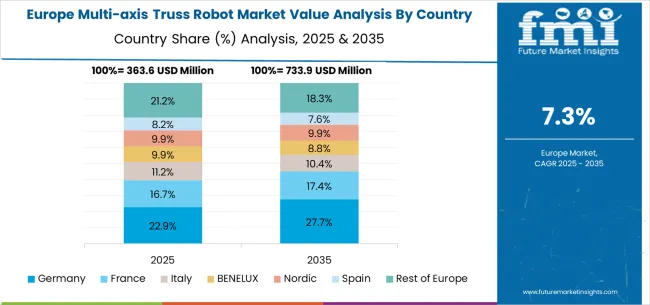
The multi-axis truss robot market in Europe is forecast to expand from USD 421.3 million in 2025 to USD 917.4 million by 2035, registering a CAGR of 8.0%. Germany will remain the largest market, holding 31.5% share in 2025, easing to 30.8% by 2035, supported by strong manufacturing infrastructure and advanced automation standards. The United Kingdom follows, rising from 22.1% in 2025 to 22.6% by 2035, driven by industrial facility modernization and automation enhancement initiatives. France is expected to maintain stability from 16.8% to 16.5%, reflecting consistent manufacturing industry investments and automation requirements. Italy holds around 13.2% throughout the forecast period, supported by manufacturing facility upgrades and automation system modernization programs. Spain grows from 9.4% to 10.1% with expanding manufacturing infrastructure and increased focus on industrial automation solutions. BENELUX markets maintain 4.5% to 4.3%, while the remainder of Europe hovers near 2.5%--2.7%, balancing emerging Eastern European manufacturing development against mature Nordic markets with established automation technology adoption patterns.
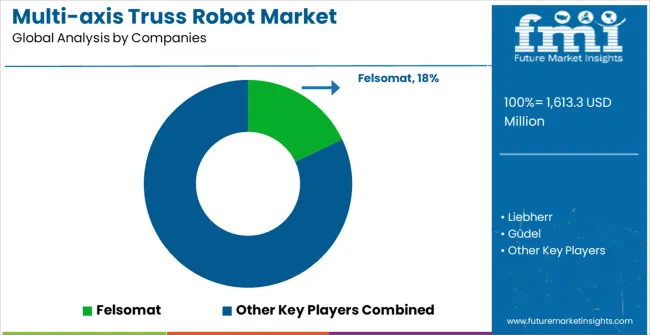
The Multi-axis Truss Robot market is defined by competition among specialized robotics manufacturers, industrial automation companies, and precision manufacturing solution providers. Companies are investing in advanced control technology development, precision optimization, artificial intelligence integration, and comprehensive automation service capabilities to deliver reliable, precise, and cost-effective manufacturing solutions. Strategic partnerships, technological innovation, and manufacturing expertise are central to strengthening product portfolios and market presence.
Felsomat offers comprehensive automation solutions with established robotics expertise and professional-grade manufacturing capabilities. Liebherr provides specialized industrial equipment with focus on precision reliability and operational performance. Güdel delivers advanced automation systems with emphasis on manufacturing efficiency and precision-friendly operation. FLT Automation GmbH specializes in robotics with advanced control technology integration.
FANUC offers professional-grade industrial robotics with comprehensive technical support capabilities. SIASUN Robot & Automation delivers established automation solutions with advanced multi-axis technologies. Qingdao Kingerobot provides specialized robotics equipment with focus on precision optimization. Lecn, Anhui Hengtong Group, STON Robot, Wuxi Xinjinyu Intelligent Manufacturing, Zhejiang Yili Robot Technology, Jiangsu Hanfeng CNC Technology, Welllih Robot, Suzhou De'ao Automation Technology, and Kunfeng Cranes offer specialized manufacturing expertise, product reliability, and comprehensive development across global and regional automation market segments.
| Item | Value |
|---|---|
| Quantitative Units | USD 1,613.3 million |
| Axis Configuration | Two-Axis, Three-Axis, Four-Axis, Five-Axis, Six-Axis, Other |
| Application | Automobile Manufacturing, Metallurgy Casting, Electronic Communications, Aerospace, Military Research |
| Regions Covered | North America, Europe, East Asia, South Asia & Pacific, Latin America, Middle East & Africa |
| Country Covered | China, India, Germany, Brazil, United States, United Kingdom, Japan, and 40+ countries |
| Key Companies Profiled | Felsomat, Liebherr, Güdel, FLT Automation GmbH, FANUC, SIASUN Robot & Automation, Qingdao Kingerobot, Lecn, Anhui Hengtong Group, STON Robot, Wuxi Xinjinyu Intelligent Manufacturing, Zhejiang Yili Robot Technology, Jiangsu Hanfeng CNC Technology, Welllih Robot, Suzhou De'ao Automation Technology, Kunfeng Cranes |
| Additional Attributes | Dollar sales by axis configuration and application segment, regional demand trends across major markets, competitive landscape with established robotics manufacturers and emerging automation providers, customer preferences for different axis configurations and precision options, integration with manufacturing systems and automation protocols, innovations in control technology and precision enhancement, and adoption of Industry 4.0 features with enhanced automation capabilities for improved manufacturing workflows. |
The global multi-axis truss robot market is estimated to be valued at USD 1,613.3 million in 2025.
The market size for the multi-axis truss robot market is projected to reach USD 3,515.5 million by 2035.
The multi-axis truss robot market is expected to grow at a 8.1% CAGR between 2025 and 2035.
The key product types in multi-axis truss robot market are two-axis, three-axis, four-axis, five-axis and six-axis.
In terms of application, automobile manufacturing segment to command 40.0% share in the multi-axis truss robot market in 2025.






Our Research Products

The "Full Research Suite" delivers actionable market intel, deep dives on markets or technologies, so clients act faster, cut risk, and unlock growth.

The Leaderboard benchmarks and ranks top vendors, classifying them as Established Leaders, Leading Challengers, or Disruptors & Challengers.

Locates where complements amplify value and substitutes erode it, forecasting net impact by horizon

We deliver granular, decision-grade intel: market sizing, 5-year forecasts, pricing, adoption, usage, revenue, and operational KPIs—plus competitor tracking, regulation, and value chains—across 60 countries broadly.

Spot the shifts before they hit your P&L. We track inflection points, adoption curves, pricing moves, and ecosystem plays to show where demand is heading, why it is changing, and what to do next across high-growth markets and disruptive tech

Real-time reads of user behavior. We track shifting priorities, perceptions of today’s and next-gen services, and provider experience, then pace how fast tech moves from trial to adoption, blending buyer, consumer, and channel inputs with social signals (#WhySwitch, #UX).

Partner with our analyst team to build a custom report designed around your business priorities. From analysing market trends to assessing competitors or crafting bespoke datasets, we tailor insights to your needs.
Supplier Intelligence
Discovery & Profiling
Capacity & Footprint
Performance & Risk
Compliance & Governance
Commercial Readiness
Who Supplies Whom
Scorecards & Shortlists
Playbooks & Docs
Category Intelligence
Definition & Scope
Demand & Use Cases
Cost Drivers
Market Structure
Supply Chain Map
Trade & Policy
Operating Norms
Deliverables
Buyer Intelligence
Account Basics
Spend & Scope
Procurement Model
Vendor Requirements
Terms & Policies
Entry Strategy
Pain Points & Triggers
Outputs
Pricing Analysis
Benchmarks
Trends
Should-Cost
Indexation
Landed Cost
Commercial Terms
Deliverables
Brand Analysis
Positioning & Value Prop
Share & Presence
Customer Evidence
Go-to-Market
Digital & Reputation
Compliance & Trust
KPIs & Gaps
Outputs
Full Research Suite comprises of:
Market outlook & trends analysis
Interviews & case studies
Strategic recommendations
Vendor profiles & capabilities analysis
5-year forecasts
8 regions and 60+ country-level data splits
Market segment data splits
12 months of continuous data updates
DELIVERED AS:
PDF EXCEL ONLINE
High-precision Truss Robot Market Size and Share Forecast Outlook 2025 to 2035
Robot Controller, Integrator and Software Market Size and Share Forecast Outlook 2025 to 2035
Robotic Warfare Market Size and Share Forecast Outlook 2025 to 2035
Robotic Lawn Mower Market Size and Share Forecast Outlook 2025 to 2035
Robotics Welding Market Size and Share Forecast Outlook 2025 to 2035
Robotic Rehab Tools Market Analysis - Size, Share, and Forecast Outlook 2025 to 2035
Robotics-Assisted Telesurgery Market Size and Share Forecast Outlook 2025 to 2035
Robotic Packaging Machines Market Size and Share Forecast Outlook 2025 to 2035
Robot Assisted Surgical Microscope Market Size and Share Forecast Outlook 2025 to 2035
Robotic Assisted Endovascular Systems Market Size and Share Forecast Outlook 2025 to 2035
Robotic Lung Biopsy Market Size and Share Forecast Outlook 2025 to 2035
Robotics as a Service (RaaS) Market Size and Share Forecast Outlook 2025 to 2035
Robotic X-ray Scanner Market Size and Share Forecast Outlook 2025 to 2035
Robotic Catheterization Systems Market Growth – Innovations, Trends & Forecast 2025-2035
Robot Sensor Market Size and Share Forecast Outlook 2025 to 2035
Robotaxi Market Size and Share Forecast Outlook 2025 to 2035
Robotic Aseptic Syringe Filler Capper Market Size and Share Forecast Outlook 2025 to 2035
Robot Market Size and Share Forecast Outlook 2025 to 2035
Robotic Vision Market Size and Share Forecast Outlook 2025 to 2035
Robotics Actuators Market Size and Share Forecast Outlook 2025 to 2035

Thank you!
You will receive an email from our Business Development Manager. Please be sure to check your SPAM/JUNK folder too.
Chat With
MaRIA